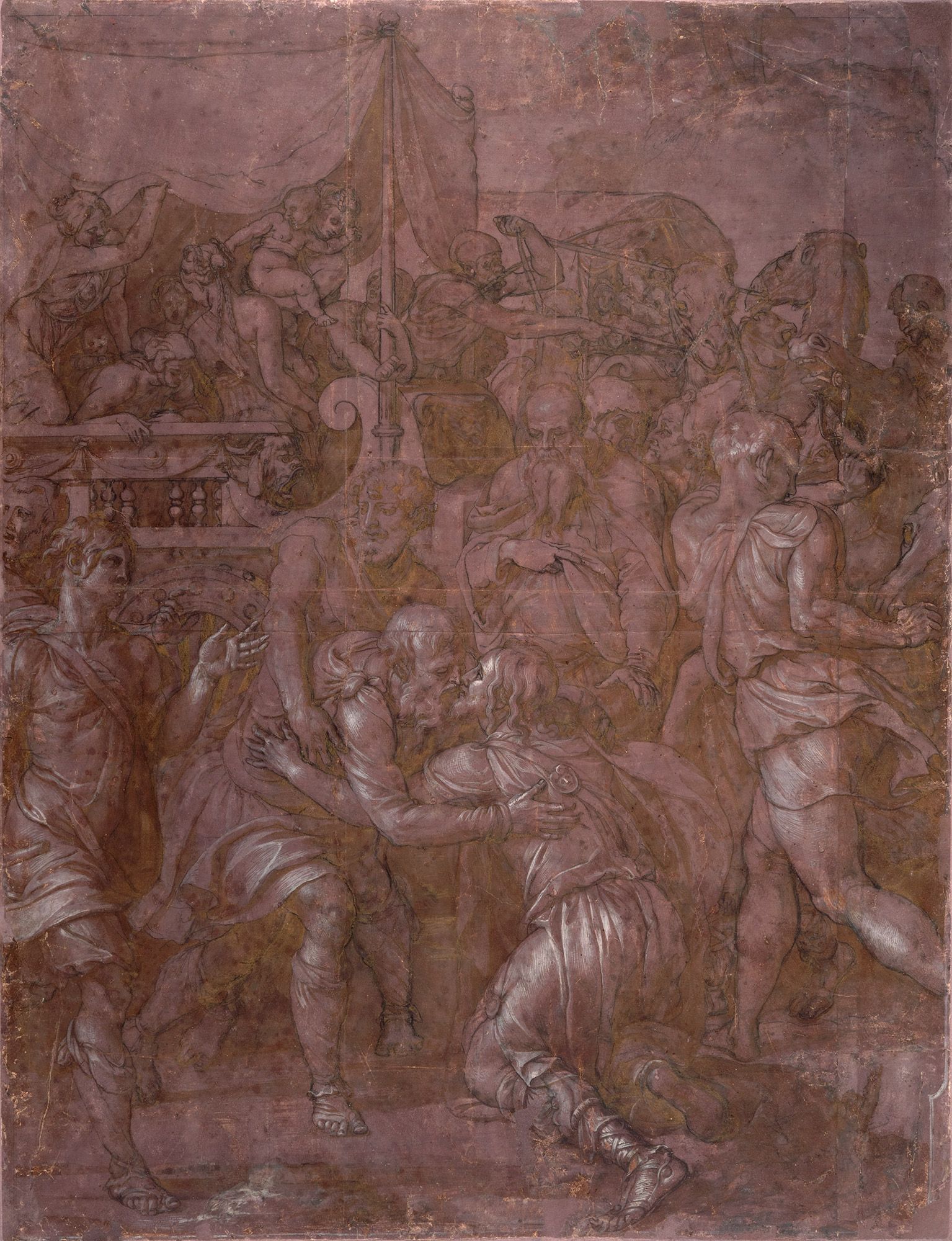FJK 061
Bronzino (Agnolo ou Allori Angelo di Cosimo) (Italian, Monticelli 1503–1572 Florence)
The Meeting of Joseph and His Father Jacob in Egypt (model for a tapestry)
ca. 1546-1553
27 23/64 × 20 29/32 in. (695 × 531 mm)
Medium
Pen, brown ink, brush, yellow-brown and mauve-purple wash, heightened with white gouache over traces of charcoal on three joined sheets of mauve prepared paper including a fragment on the right
Origin
Gallery Samuel, Petty France, Westminster, London
Paul Ayshford Methuen Collection, 4th Baron Methuen (around 1925)
Methuen Collection, Corsham Court, Wiltshire
Sale, Sotheby’s, London, July 3, 1996, no. 10
Jan Krugier Collection, Monaco, JK 5378
Jan Krugier Foundation
Bibliography
ADELSON Candace J.,Palazzo Vecchio, Committenza e collezionismo medici. Firenze et la Toscana dei Medici nell'Europa del Cinquecento, exh. cat., Florence, 1980, p. 62, mentioned under no. 96.
McCORQUODALE Charles, Bronzino, London: Jupiter Books, 1981, p. 103, ill. p. 112, pl. 72.
ADELSON Candace J.,The Tapestry Patronage of Cosimo I de’ Medici, 1545-1553,Ph. D., New York University, 1990, vol. 2, p. 387, no. 26, fig. 120.
McCORQUODALE Charles, Bronzino, London, 2005, p. 122, pl. 85.
PILLIOD Elizabeth, “Method and Practice in Bronzino’s Drawing Modes: From Study to Modello,” in Artibus et Historiae, 27, 2006, pp. 99, 110, 122, 124, no. 19, fig. 4.
BAMBACH Carmen C., COX REARICK-Janet, GOLDNER George R., The Drawings of Bronzino, New Haven & London: Yale University Press, 2010, p. 174, no. 41, color ill. p. 175.
Exhibitions
Berlin, Kupferstichkabinett, Staatliche Museen zu Berlin - Preussischer Kulturbesitz, Linie, Licht und Schatten. Meisterzeichnungen und Skulpturen der Sammlung Jan und Marie-Anne Krugier-Poniatowski, 1999, p. 58, no. 22, color ill. p. 59.
Venice, Peggy Guggenheim Collection, Solomon R. Guggenheim Foundation, The Timeless Eye. Master Drawings from the Jan and Marie-Anne Krugier-Poniatowski Collection, 1999, p. 76, no. 31, color ill. p. 77.
Madrid, Museo Thyssen-Bornemisza, Miradas sin Tiempo. Dibujos, Pinturas y Esculturas de la Coleccion Jan y Marie-Anne Krugier-Poniatowski, 2000, p. 82, no. 26, color ill. p. 83.
Paris, Musée Jacquemart-André, La Passion du Dessin. Collection Jan et Marie-Anne Krugier-Poniatowski, 2002, p. 80, no. 28, color ill. p. 81.
Munich, Kunsthalle der Hypo-Kulturstiftung, Das Ewige Auge - Von Rembrandt bis Picasso. Meisterwerke aus der Sammlung Jan Krugier und Marie-Anne Krugier-Poniatowski, 2007, p. 84, no. 34, color ill. p. 85.
New York, The Metropolitan Museum of Art, The Drawings of Bronzino, 2010, p. 174, no. 41, color ill. p. 175.
Notes
Notes (1)
This drawing will be reproduced in the Catalogue Raisonné of Bronzino in preparation under the direction of Lea Mendelsohn.
Notes (2)
Between 1546 and 1553, Cosimo I of Medici (1537-1574) commissioned twenty tapestries to Jacopo Pontormo, Agnolo Bronzino and Francesco Salvati for the Sala dei Duecento at the Palazzo Vecchio in Florence. He had come to power eight years earlier and had become one of the most powerful statemen of the sixteenth century. This was the most important commission since the tapestry cartoons by Raphael for the Sistine Chapel. The choice of the story of Joseph was made to glorify Cosimo. Today, the tapestries are displayed in the Palazzo Vecchio and the Quirinal Palace in Rome.
Instead of having the tapestries made abroad, Cosimo invited the two Flemish tapestry masters, Ian Rost and Nicolas Karcher, so as to develop local craftsmanship. Bronzino executed sixteen drawings, his master Pontormo three and Salviati only one. None of these cartoons have survived.
This set is the highlight of Bronzino’s career. Like in the other preparatory studies preserved in Berlin, at the Ashmolean and Christ Church in Oxford, at the Uffizi and at the British Museum (tapestry borders), the composition is reversed from the tapestries, but hardly differs.
This series comprises Bronzino’s most important innovations. The foreground is built with powerful figures while the background is filled with elaborate architectural details. The rich positions of the main figures and the different views they present demonstrate the artist’s brilliant mastery, which heralds Florentine Mannerism. In moving forward vigorously towards the left, Joseph’s brother responds to the horse tamer on the right. Theories of the time explicitly recommended to design complex attitudes.
The profusion of ornaments and the multitude of movements could overshadow the narrative, but the artist uses white highlights to isolate the four figures of the foreground to draw the viewer’s attention to them. Despite their volume, they look flat and seem to come out of a frieze. The extraordinary precision of the line is reminiscent of etching. And the perfectly mastered outlines of the figures are characteristic of Bronzino’s style, worthy heir to the Italian disegno, unlike Titian who modelled his form with colors.
In some areas, pentimenti shed light on the master’s creative process, as shown by the outline of the horse tamer.
Matthias Weniger, La Passion du Dessin, Paris, Musée Jacquemart-André, 2002, p. 80 (extracts translated from French)
Request for information/loan
The Jan Krugier Foundation is devoted to increasing the impact of the collection of drawings through regular loans to major exhibitions. Loan applications should include a complete presentation of the project.

